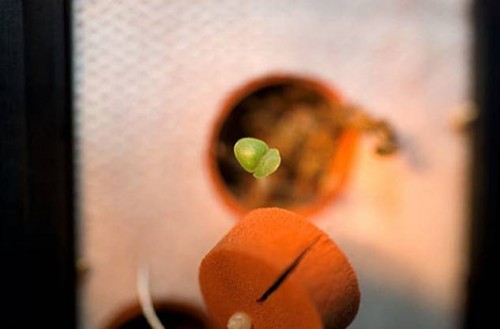
A small green sprout of cinnamon basil, growing on board the International Space Station in 2007. (Courtesy: NASA)
By Tushna Commissariat
Early this week, a story in the Telegraph caught our eye – NASA is planning on sending turnip, cress and basil seeds to the Moon to germinate them! This is most definitely not the first time that plants have been grown beyond the realms of Earth. Indeed, potatoes were grown on board during a 1995 Space Shuttle mission and many experiments involving germinating seeds were done on the International Space Station. The goal of these studies was to understand the effects of microgravity on plant growth. But now, NASA plans to take this one step further in 2015 with their Moon Express mission, which will include the Lunar Plant Growth Chamber that will carry seeds and enough air and nutrients to allow the seeds to sprout and grow. Will fresh salad be on an astronaut’s menu soon?
Last week, we released Physics World’s shortlist for our Book of the Year 2013. We will be revealing our winner in our Book of the Year podcast on Monday 17 December so do tune in for that. But until then, you might want to also take a look at science-writer Jennifer Ouellette’s “Baker’s Dozen: Best 2013 Books for the Physics Fan” list. We too have reviewed The Particle at the End of the Universe and The Theoretical Minimum: What You Need to Know to Start Doing Physics, and will be reviewing some of the other titles on her list early next year so check back for more. In the meantime, make sure you add lots of good physics books to your Christmas present list!
We also spotted this rather fascinating, if slightly disturbing, feature on the Nautilus website about the “elephant’s foot”, which is the most lethal piece of nuclear waste on the planet. Science writer Kyle Hill hauntingly describes the “foot” – a remnant of the Chernobyl nuclear disaster – that is a toxic mix of melted concrete, sand and core shielding material that melted together. Even today, a mere hour of exposure to it will cost you your life. Read the feature to find out just how the emergency crews dealing with the disaster dealt with the foot and how in the world they actually managed to photograph and take samples of it at the time.
In other news this week, the Guardian newspaper published a rather worrying story on the fate of graphene and its implementation in industry in the UK. Writer Aditya Chakrabortty spelled doom for the “wonder material” in the UK, suggesting that UK firms would not be much involved in creating the graphene-based devices of the future. Physics World’s editor Matin Durrani and others did not agree completely with his view – read what Matin had to say in his letter to the Guardian here.
Also, CERN director Rolf-Dieter Heuer has responded to a recent article in the Economist magazine – “How science goes wrong” – that bemoaned all that is wrong with scientific practice today. Heuer responded with a letter to the Economist as well as a longer article in Prospect magazine.
And lastly, read about this account of physicist Jacquiline Romero’s positive and fruitful experience on having a child while in the midst of pursuing her PhD, what it was like for physicist Philip Moriarty to be a scientist accompanying an MP in the British parliament and how to make Star Wars snowflake decorations for your Christmas tree!
I know this is only question. But cant we measure by some way quantum gravity on grown plants in Space?